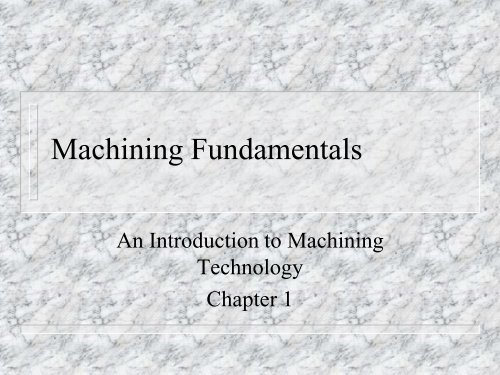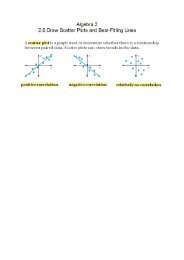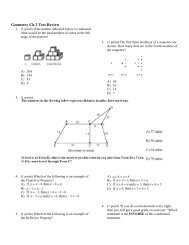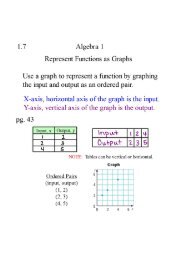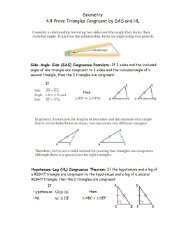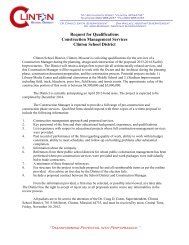Machining Fundamentals
Machining Fundamentals
Machining Fundamentals
Create successful ePaper yourself
Turn your PDF publications into a flip-book with our unique Google optimized e-Paper software.
Example• If machine tools were not available tomanufacture tractors and farmingimplements, farmers might still be plowingwith oxen and hand forged plowshares.
!!! Important Point !!!• The high-paying skilled jobs inmanufacturing, such as tool and die makingand precision machining, Require aptitudescomparable to those of college graduates.
Name a Product• That does not require, either directly orindirectly, the use of a machine toolsomewhere in its manufacture.
The Evolution of Machine Tools
Machine Tools• As a group, can reproduce themselves.• Many variations of each type of machinetools• Small enough to fit on a bench top tomachines weighing several hundred tons• How could there be machine tools whenthere were no machine tools to make them?
Early Machine Tools
1200B.C.• The first machine tools, the bow lathe andbow drill, were hand-made.• Until the end of the 17th century the lathecould only be used to turn softer materials.• Wood, ivory, soft metals like lead orcopper.
Early Machine Tools• All of them were human powered• bow lathes reciprocation motion gave wayto treadle power.• Work rotation was continuous in onedirection.
Bow Drill
Bow Lathe
Great Wheel Lathe
Spring Pole Lathe
Treadle Lathe
Early Machine Tools• James Watt first experimented with hissteam engine.• This brought about the first true machinetool.• Boring mill• The water powered tool was developed in1774 by Englishman John Wilkinson.
Early Machine Tools• 1800 the first lathe capable of cuttingaccurate screw threads.• Designed by Henry Maudslay, an Englishmaster mechanic and machine toolmaker.• Maudslay’s lathe is considered theGranddaddy of all modern chip-makingmachine tools.
Thread Cutter
Early Machine Tools• Industrial Revolution could not have takenplace if there had not been a cheap,convenient source of power; the SteamEngine.• Industry had to locate near source of waterpower.
Early Machine Tools• 1820 Eli Whitney, an American inventorand manufacturer, devised a system to massproduce muskets (guns)• Whitney began using milling machine tomake interchangeable musket parts.• Whitney had problems
Early Machine Tools• Whitney used several armories producinggun parts.• There was no standard of measurement atthat time• The Mid 1860 the United States adapted astandard measuring system.
Early Machine Tools• 1875 basic machine tools such as the lathe,the milling machine, and the drill presswere capable of attaining accuracy's of oneone-thousandth of an inch.• America was well on its way to becomingthe greatest industrial nation in the world.
Power Sources• As machine tools were improved, so wasthe way they were powered.• At first, the changes were very slow, takinghundreds of years.• The changes have come only in the last 150years or so.
Hand power• The bow lathe and bow drill are examples,• Direction of rotation changed at each strokeof the bow.
Foot Power• A treadle or a treadmill made possiblecontinuous rotation of the work in onedirections
Animal Power• Treadmills were used to power earlydevices for boring cannon barrels.• Human foot power was not sufficientlystrong for this work.
Water Power• Not always dependable as a power source,because of lack of water during dry seasons.
Steam Power• The first real source of dependable power.• A centrally located steam engine turnedshafts and overhead pulleys that were beltedto the individual machines.
Central Electrical Power• Large electric motors simply replaced thesteam engines.• Power transmission to the machine did notchange.
Individual Electrical Power• Motors were built into the individualmachine tools.• Overhead belting was eliminated.
Basic Machine Tool Operation
Lathe• Almost all machine tools have evolved fromthe lathe• The lathe performs one of the mostimportant machining operations• It operates on the principle of work beingrotated against the edge of a cutting tool.
Lathe• Many other operations• Drilling, boring, thread cutting, milling andgrinding, can be performed on a lathe.• The most advanced version of the lathe isthe CNC turning center.
Drill Press• Rotates a cutting tool against the materialwith sufficient pressure to cause 6the tool topenetrate the material.• Used for cutting round holes.• Some are designed to machine holes assmall as 0.0016 in diameter.
Grinding Machines• An operation that removes metal by rotatinga grinding wheel or abrasive belt against thework.• Offhand Grinding. Work that does notrequire great accuracy is hand held andmanipulated until ground to the desireshape.
Grinding Machines• Precision Grinding. Only a small amount ofmaterial is removed with each pass of thegrinding wheel.• Smooth, accurate surface• Precision grinding is a finishing operation.
Band Machines• A widely employed technique that makesuse of a continuous saw blade.• Chip removal is rapid and accuracy can beheld to close tolerances.• Elimination or minimizing many secondarymachining operations
Milling Machine• Rotates a multi-toothed cutter into the work.• Variety of cutting operations can beperformed on milling machines
Broaching Machines• Designed to push or pull a multi-toothedcutter across the work.• Each tooth of the broach (cutting tool)removes only a small amount of thematerial being machined.
Nontraditional <strong>Machining</strong>Processes• <strong>Machining</strong> operations that have not evolvedfrom the lathe.
Electrical Discharge <strong>Machining</strong>(EDM)• An advanced machining process that uses afine, accurately controlled electrical sparkto erode metal.
Electrochemical <strong>Machining</strong>(ECM)• A method of material removal that shapes aworkpiece by removing electrons from itssurface atoms• ECM is exactly the opposite ofelectroplating
Chemical Milling• A process in which chemical are employedto etch away selected portions of metal.
Chemical Blanking• A material removal method in whichchemicals are employed to produce small,intricate, ultra-thin parts by etching awayunwanted material.
Hydrodynamic <strong>Machining</strong>(HDM)• A computer-controlled technique that uses a55,000 psi water jet to cut complex shapeswith minimum waste.• The work can be accomplished with orwithout abrasives added to the jet.
Ultrasonic <strong>Machining</strong>• A method that uses ultrasonic sound wavesand an abrasive slurry to remove metal.
Electron Beam <strong>Machining</strong>(EBM)• A Thermoelectric process that focuses ahigh-speed beam of electrons on the workpiece.• The heat that is generated vaporizes themetal.
Laser <strong>Machining</strong>• The laser produces an intense beam of lightthat can be focused onto an area only a fewmicrons in diameter.• It is useful for cutting and drilling.
Hexapods• CNC has made possible unconventionalmachine tools that use new workpositioning and tool-positioning concepts
Automating the <strong>Machining</strong>Process• 1940’s US Air Force was searching forways to increase production on complexparts for the now jet aircraft and missiles• The Parsons Corporation, a manufacturer ofaircraft parts, had developed a two-axistechnique for generating data the checkhelicopter blade airfoil patterns.
Automating the <strong>Machining</strong>Process• The Parsons Corporation system usedpunched-card tabulating equipment.• To determine the accuracy of the data, apattern was mounted on a Bridgeportmilling machine.
Automating The <strong>Machining</strong>Process• A dial indicator in place, the X andY pointswere called out to a machinist operating themachines X-axis handwheel and anothermachinist who controlled the y-axishandwheel.• With enough reference points established,the generated data proved accurate to +/-0.0015”
The development on NumericalControl• Parsons realized that the technique mightalso be developed into a two-axis or eventhree-axis machining system.• 1952 Massachusetts Institute of Technologydesigned a control system and mounted iton a vertical spindle machine tool• binary number system• Coined the phrase NC
Computer Numerical Control• 1970 introduction of the microchip.• Use of onboard computers an individualmachine tools• Led to the introduction of computernumerical control (CNC• Programs could be made at the machine ordownloaded by direct line from an externalcomputer.
CNC• Accuracy. It is capable of producingconsistent and accurate work-pieces.• Repeatability. It is able to produce anynumber of identical work-pieces once aprogram is verified.• Flexibility. Changeover to running anothertype of part requires only a short period ofnonproductive machine downtime.
Robotic Systems• For loading and unloading permits some machinetools to operate unattended• Operate in hazardous and harsh environments.• Perform operations that would be tedious for ahuman operator.• Handle heavy materials.• Position parts with great repetitive precision.
The Evolving Role of theMachinist• Make a thorough study of the print• Determine the machining that must be done• Ascertain tolerance requirements.• Plan the machining sequence.• Determine how the setup will be made.• Select the machine tool, cutters and othertools and equipment that will be needed.
Role of the Machinist• Calculate cutting speeds and feeds.• Select a proper cutting fluid for the materialbeing machined.
?????Any Questions?????


